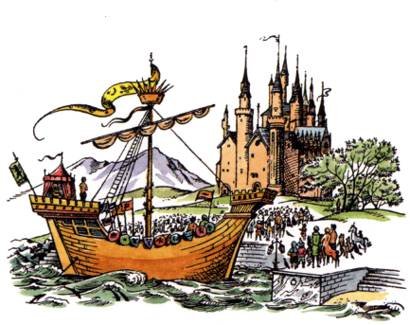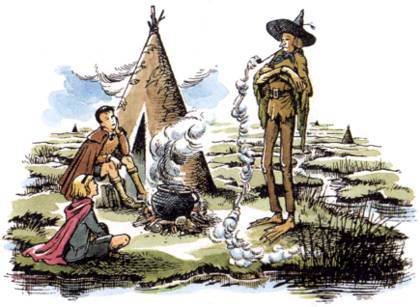Tolkien's "Eucatastrophe" in Lewis's The Silver Chair
In his essay “On Fairy Stories,” J.R.R. Tolkien coins the term “eucatastrophe” which is the sudden happy ending in the story; a turning of events that fills the reader with joy, for joy is “the mark of the true fairy-story” (Tolkien 23).
"Joy is the mark of the true fairy-story."
-J.R.R. Tolkien

(If you haven’t had a chance to read Tolkien’s essay, I highly recommend it. You can find the full essay here: http://brainstorm-services.com/wcu-2004/fairystories-tolkien.pdf).
Tolkien says that “the eucatastrophic tale is the true form of fairy-tale, and its highest function” (22). In other words, all true fairy stories should have a sudden happy ending that fills you with joy. Since The Silver Chair by C.S. Lewis falls into the realm of fairy story, it is no surprise that eucatastrophe is present in the final chapter, emerging in King Caspian’s resurrection and the healing of all harms.
Eucatastrophe in The Silver Chair
For there to be eucatastrophe in a story, there must first be sorrow, for this “is necessary to the joy of deliverance” (Tolkien 22). In the same way, there cannot be true joy in the finale of The Silver Chair without the death of King Caspian. Eustace and Jill successfully rescue Prince Rilian only to witness the tragically short reunion between Rilian and his father before Caspian dies. The narrator allows the characters (and the reader) to mourn for Caspian, for the reader must remain in tears for a few pages longer in order for the joy of Caspian’s resurrection to be fully felt. The narrator describes the Narnians taking off their hats, bringing the flag down to half-mast, and playing a mournful tune enough “to break your heart” (Lewis 209-10). Eustace, Jill and Aslan return to Aslan’s Mountain and see Caspian lying dead in a stream. All three, even Aslan, break down and weep as the funeral music for Caspian continues to be heard on the Mountain of Aslan (Lewis 211). Because the narrator allows the reader time to grieve, it is truly a most joyous turn of events when the dead King comes back to life (Lewis 212). The doleful music stops and the old dead King is transformed into a very much alive and laughing young man (Lewis 212). From this point to the end of the story, all sorrow is ousted from the narrative. Caspian gives a “great laugh of astonished joy” when he is united with Eustace (Lewis 213). There is even great joy in death, for, as Aslan tells Caspian, “You cannot want wrong things anymore, now that you have died” (Lewis 214). Caspian is given a new life where he is pure and unable to do wrong. King Caspian’s death and the sorrow that surrounds the event is necessary in the story in order for there to be complete and utter joy in his later resurrection.
The resurrection of Caspian is only one of the joyful events that occur in the final chapter of The Silver Chair. Back at Experiment House, a place of sorrow for Eustace and Jill, Aslan sees that all things are put to right: the bullies are taught a lesson by Jill, Eustace, and Caspian and the Head of the school is replaced. Because of this, Experiment House becomes “quite a good school,” which is a joyous turn of events for Eustace and Jill (Lewis 216). Back in Narnia, Rilian “[rules] Narnia well and the land [is] happy in his days” (Lewis 216). The ending of The Silver Chair is one of complete joy: all hurts are healed; Caspian is alive, Experiment House is changed for the better and Narnia is safe and happy.
Further Thoughts
The joy that the reader feels when reading the eucatostraphic ending of Lewis’ fairy tale, The Silver Chair, is only magnified when it is paralleled with the great hope and joy of Heaven and Resurrection in the Primary World. The Silver Chair is a lasting story because the events of the book look towards a Greater Story. As Tolkien says: “in the ‘eucatastrophe’ we see in a brief vision that the answer may be greater—it may be a far-off gleam or echo of evangelium in the real world” (23). Lewis gives the reader a glimpse of this evangelium, the good news, when he imagines the Christian hope of resurrection, heaven and new life in The Silver Chair through Caspian’s experience.
Where do you see eucatastrophe in other stories? Do you agree with Tolkien and see eucatastrophe in fairy stories reflecting "a Greater Story" in the Primary World?

Artwork by Pauline Baynes (drawn for the first publications of The Chronicles of Narnia)
Lewis, C.S. The Silver Chair. Macmillan Publishing Co., 1970.
Tolkien, J.R.R. “On Fairy Stories.” Essays Presented to Charles Williams. Wm. B Eerdmans, 1947.
I don’t know that every fairy story has a happy ending. Some of the original fairy tales are dark as a moonless night, with chubby German children eaten by gnarled old witches.
Though I suppose that could be a happy ending, if you cast the witch as the protagonist.
i agree with you,,
That's certainly true! Most of the original fairy tales (like the Grimm brothers) are pretty dark, but Disney likes to clean them up and give them super happy endings. It's a good reminder that fairy tales are not all "once-upon-a-time....happily-ever-after" stories.
Congratulations @rennoelle! You have completed some achievement on Steemit and have been rewarded with new badge(s) :
Click on any badge to view your own Board of Honor on SteemitBoard.
For more information about SteemitBoard, click here
If you no longer want to receive notifications, reply to this comment with the word
STOP